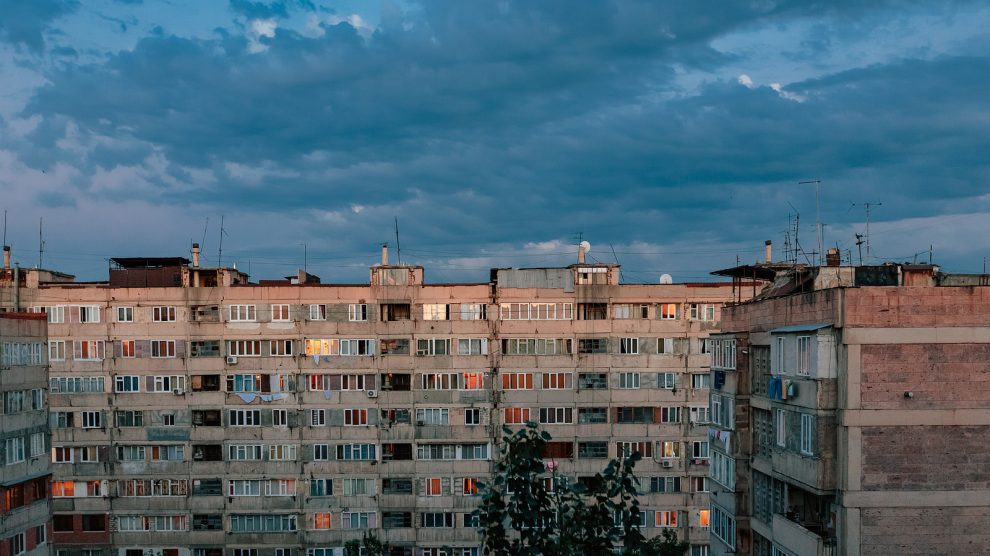Since a 1988 earthquake killed tens of thousands and left half a million people homeless, Armenia has taken steps to study earthquake hazard, update construction codes, and retrofit older buildings. But while Armenia’s rescuers help earthquake victims abroad, there is still more work to be done at home.
At 11:41 on December 7, 1988, a devastating earthquake measuring 6.8 on the Richter scale struck northern Armenia.
Children were at school and adults were at work when the disaster hit. The official death toll was 25,000, but some estimate as many as 50,000 people were killed. Suren Arakelyan, the director of the Georisk Scientific Research Company in Armenia, says 45,000 people were recovered from the rubble and 514,000 were left homeless.
- Postcard from Bucharest: Shaky foundations
- Armenia and Turkey’s frosty relationship thaws amid earthquake diplomacy
- Explainer: Azerbaijan, Iran and the crisis in the South Caucasus
Arakelyan estimates nine million square metres of residential living space was lost and direct material losses reached 20 billion US dollars. The quake destroyed 90 per cent of Spitak and is often called the Spitak earthquake, but it also destroyed half of Armenia’s second-largest city of Gyumri, at the time still known as Leninakan.
Schools and every hospital around Spitak were destroyed. At least 130,000 Armenians were injured, but given that 80 per cent of medical staff were killed, offering the injured treatment was difficult. Two-thirds of victims were children under the age of 18.
Soviet leader Mikhail Gorbachev formally asked the United States and the international community for humanitarian assistance; 113 countries sent aid and rescuers.
“The first and main reason” the quake was so devastating was that “seismic hazard was underestimated,” Dr Hrachya Petrosyan, the former head of Armenia’s National Survey for Seismic Protection, tells Emerging Europe.
“The second reason was that in the country, there had been a few models of building and the experience of the Spitak earthquake proved that some of these could withstand the shaking but some could not. After the Spitak earthquake, the seismic behaviour of buildings was analysed in detail and design models that were not capable of withstanding the shaking were discontinued,” Dr Petrosyan explains.
In Gyumri, 96 of 135 buildings following a nine-story Soviet design collapsed in the 1988 quake. Today, some 14 per cent of buildings in Armenia’s capital, Yerevan, are of the same model.
Dr Petrosyan notes that corruption, the illegal sale of low-quality construction materials, and impromptu local changes to structural elements of pre-approved building designs contributed to poor levels of earthquake-resistent construction.
Seismic protection
Two and a half years after the quake, in 1991, Armenia – by now independent – created the National Survey for Seismic Protection. The agency collects and analyses data to assess current seismic hazard and reduce seismic risk by increasing population awareness through education on seismic protection behaviour rules.
In 1999, two state programmes for seismic risk reduction were launched and implemented in the city of Yerevan and across Armenia, respectively. In 2002, after consulting with international experts, Armenia’s Law on Seismic Protection became the first of its kind in the former Soviet Union.
Recent research suggests that the most earthquake-prone areas of Armenia are at risk of earthquakes of 9.0 magnitude on the logarithmic Richter scale—over one hundred times more powerful than the 1988 Spitak quake. 90 per cent of school buildings in Armenia date back to the Soviet era, when building plans were only designed to withstand 7.0 magnitude quakes (though construction shortcuts diminished their resilience). If a 9.0 earthquake hit Armenia, between 70 and 80 per cent of buildings could be severely damaged.
Funded by the Asian Development Bank (ADB), a consortium of three companies from Italy, the US, and Armenia has worked with the World Bank to develop a comprehensive map of seismic hazard in Armenia based on the maximum expected magnitude earthquake in each area.
Legally-binding earthquake resistant construction design codes require engineers and planners to construct buildings according to standards that correspond with their exposure to seismic hazard. The codes were most recently updated in December 2020.
“The preparation and adoption of the map really was a milestone in earthquake resistant construction in Armenia”, Dr Petrosyan says.

Problems persist
Nevertheless, issues remain. Some developers allegedly bribe private inspectors to sign off that their building plans are seismic-proof, and while 89.3 million US dollars of assistance from the ADB has recently retrofitted four dozen schools, there are many more Soviet-era buildings still in need of renovation.
Despite this, because of the pro-active action taken since 1988, the situation in Armenia looks much brighter than in neighbouring Turkey. The country has meaningfully invested in its earthquake resilience which should make a huge contribution to mitigating damage as and when a new earthquake hits the country.
Indeed, when massive earthquakes killed thousands in Turkey and Syria in February, Armenia dispatched shipments of aid and rescuers to save people from rubble—despite lacking formal diplomatic relations with the latter.
Unlike many news and information platforms, Emerging Europe is free to read, and always will be. There is no paywall here. We are independent, not affiliated with nor representing any political party or business organisation. We want the very best for emerging Europe, nothing more, nothing less. Your support will help us continue to spread the word about this amazing region.
You can contribute here. Thank you.







Add Comment